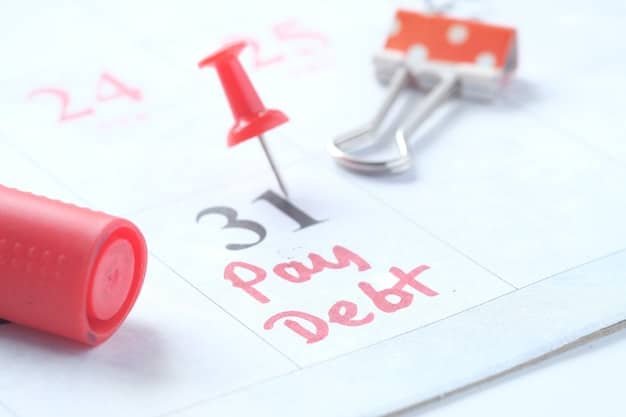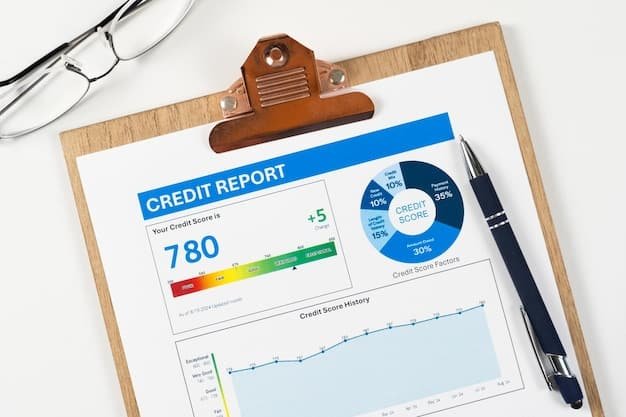Rebuild Your Credit Score After Debt Settlement: Step-by-Step 2025 Guide

Rebuilding your credit score after debt settlement involves several strategic steps, including monitoring your credit report, securing a secured credit card, making timely payments, and keeping credit utilization low; following these steps can lead to a significantly improved credit score by 2025.
Settling debt can provide immediate relief, but it often negatively impacts your credit score; understanding how to rebuild your credit score after debt settlement: a step-by-step guide for 2025 is essential for long-term financial health. This guide outlines practical strategies to help you regain a good credit standing.
Understand the Impact of Debt Settlement
Debt settlement can significantly lower your credit score initially; understanding how this process affects your credit report is the first step toward recovery. Being aware of what caused the dip will help you tailor your rebuilding strategy.
How Debt Settlement Affects Credit Scores
Debt settlement appears on your credit report and usually indicates that you paid less than the full amount you owed; this is seen as a negative factor by credit scoring models. The impact decreases over time as more positive financial behavior is reported.
Different credit scoring models weigh debt settlement differently; FICO and VantageScore are the two main scoring models, with various versions in use. Awareness of these nuances can help you understand your credit score better.

- Payment History: Payment history is the most influential factor in your credit score; a history of late or partial payments negatively impacts your score significantly.
- Amounts Owed: This involves the total debt you carry, and high outstanding balances can lower your score. Debt settlement reduces this amount, but the settlement itself is a negative mark.
- Length of Credit History: A longer credit history typically results in a better credit score; new credit lines after debt settlement won’t immediately boost your score, but they can help over time.
Understanding the mechanics of credit scoring makes rebuilding your credit more effective; by focusing on the factors that matter most, you can see improvements faster.
Monitor Your Credit Report
Regularly monitoring your credit report is crucial when rebuilding your credit after debt settlement; this allows you to identify inaccuracies and track your progress. It also helps you ensure that your credit information is being reported correctly.
How to Obtain Your Credit Report
You are entitled to a free credit report from each of the three major credit bureaus (Equifax, Experian, and TransUnion) every 12 months; access these reports via AnnualCreditReport.com, the only authorized website for free annual credit reports. Review these reports carefully to ensure all information is accurate and up to date.
Check for any errors, such as incorrect account balances or misreported payment statuses; disputing these errors can help improve your credit score. Keep records of all disputes filed with the credit bureaus.
What to Look for in Your Credit Report
Pay close attention to the accounts included in the debt settlement; make sure they are accurately reported as settled and not still showing as active with past due amounts. Confirm that all settlement agreements are correctly reflected.

- Personal Information: Verify your name, address, and Social Security number are correct.
- Account Details: Ensure all open and closed accounts are listed accurately, including credit limits, balances, and payment history.
- Inquiries: Check the list of inquiries to ensure you recognize each one; unauthorized inquiries can be a sign of identity theft.
Consistent monitoring of your credit report helps you stay on top of your credit health and address any issues promptly; this proactive approach is key to rebuilding your credit after debt settlement.
Secure a Secured Credit Card
A secured credit card is a valuable tool for rebuilding credit; it allows you to establish or re-establish a positive credit history with minimal risk to the lender. This is often the quickest way to demonstrate responsible credit use.
What Is a Secured Credit Card?
A secured credit card requires you to provide a cash deposit as collateral; this deposit usually serves as your credit limit. The card works like a regular credit card, and your payment activity is reported to the credit bureaus.
Secured cards are easier to obtain than unsecured cards, especially if you have a low credit score after debt settlement. They provide a safe way to rebuild credit without accumulating more debt.
When choosing a secured credit card, look for low fees, reporting to all three major credit bureaus, and the possibility of upgrading to an unsecured card after a period of responsible use; compare offers from different issuers to find the best terms.
How to Use a Secured Credit Card Effectively
Use your secured card for small, manageable purchases that you can easily repay each month; this demonstrates responsible credit management. Avoid maxing out the card, as high credit utilization can negatively impact your score.
- Keep Balances Low: Aim to keep your credit utilization below 30% of your credit limit; for example, if your limit is $500, try to keep your balance below $150.
- Make Timely Payments: Always pay your bill on time, every time; consider setting up automatic payments to avoid missed deadlines.
- Monitor Your Credit Report: Regularly check your credit report to ensure your payments are being reported correctly and track your progress.
Using a secured credit card wisely can significantly improve your credit score over time; consistent responsible use demonstrates to lenders that you are a reliable borrower.
Make Timely Payments
Consistent, on-time payments are crucial for rebuilding your credit; payment history is one of the most significant factors influencing your credit score. Making payments punctually shows lenders you can manage credit responsibly.
Why Payment History Matters
A history of late payments can severely damage your credit score and remain on your credit report for up to seven years; even one missed payment can have a negative impact. Conversely, a long history of on-time payments can significantly boost your credit score.
Lenders view borrowers with a strong payment history as lower risk; this makes you more likely to be approved for loans, credit cards, and other financial products. Timely payments also help you avoid late fees and additional interest charges.
Strategies for Making Payments on Time
Set up automatic payments to ensure you never miss a due date; most banks and credit card issuers offer this service. Choose a payment date that aligns with your income cycle to ensure you have sufficient funds available.
- Create Reminders: Use calendar reminders or mobile apps to remind you of upcoming payment deadlines.
- Budget Effectively: Ensure you have a clear budget that allocates funds for all your bills and financial obligations.
- Prioritize Bills: Make sure to prioritize your credit payments to avoid late fees and negative credit reporting.
By prioritizing timely payments, you are actively building a positive credit history and steadily improving your credit score; consistency is key to long-term success.
Keep Credit Utilization Low
Maintaining low credit utilization is essential for a healthy credit score; credit utilization refers to the amount of credit you’re using compared to your total available credit. Aiming for low utilization demonstrates responsible credit management.
Understanding Credit Utilization
Credit utilization is calculated by dividing the total amount of credit you’re using by your total available credit; lenders typically prefer borrowers who keep their utilization below 30%. High credit utilization can signal financial stress and increase your perceived risk as a borrower.
For example, if you have a credit card with a $1,000 limit, keeping your balance below $300 would result in a credit utilization of 30%. Staying within this range shows lenders that you are managing your credit responsibly.
Strategies for Lowering Credit Utilization
Make multiple payments throughout the month to keep your balance low; this strategy can help you avoid reporting high balances to the credit bureaus. Consider increasing your credit limits, but only if you can resist the temptation to spend more.
Balance transfers can consolidate debt and potentially lower your credit utilization; however, be mindful of transfer fees and interest rates. A lower credit utilization ratio shows that you are managing your credit effectively and that you are not overextended.
Maintaining low credit utilization requires discipline and awareness; by actively managing your credit balances, you can improve your credit score and demonstrate financial stability to lenders.
Consider a Credit-Builder Loan
A credit-builder loan is designed to help people with little or no credit history establish a positive credit track record; it can be a useful tool for those rebuilding their credit after debt settlement. You should be aiming for a responsible way of borrowing.
How Credit-Builder Loans Work
With a credit-builder loan, you make fixed monthly payments over a set period; the payments are reported to the credit bureaus, helping you build a positive payment history. Unlike traditional loans, the funds from a credit-builder loan are often held in a secure account until the loan is paid off.
Credit-builder loans are typically offered by credit unions, community banks, and online lenders; compare the terms and conditions from different lenders to find the best fit for your needs. Paying a loan successfully is a great sign for anyone.
Look for loans with low interest rates and minimal fees; ensure the lender reports to all three major credit bureaus. Before taking out a credit-builder loan, evaluate your financial situation and ensure you can comfortably afford the monthly payments.
Benefits of Credit-Builder Loans
Credit-builder loans provide a structured way to build credit; they can be particularly helpful for individuals who have limited credit history or a damaged credit score. They also encourage savings as the loan proceeds are often held in an account until repayment is complete.
Responsible repayment of a credit-builder loan can significantly improve your credit score over time; it demonstrates to lenders that you are a reliable borrower. A credit score based on various things is helpful.
Conclusion
Rebuilding your credit score after debt settlement is a manageable process; by consistently monitoring your credit report, securing a secured credit card, always paying on time, keeping credit utilization low, and looking into credit-builder loans, you can build a stronger credit profile by 2025.
| Key Point | Brief Description |
|---|---|
| 🔍 Monitor Credit | Regularly check reports for errors and track improvements. |
| 💳 Secured Card | Use for small purchases, keep balance low, and pay on time. |
| 🗓️ Timely Payments | Set reminders and automate payments to avoid missing deadlines. |
| 💰 Low Utilization | Keep balances below 30% of your credit limit to show responsibility. |
FAQ
▼
Debt settlement can negatively impact your credit score for up to seven years, but the effect diminishes over time as you establish positive credit habits.
▼
Aim for a credit score of 700 or higher to be considered a good credit risk. This will improve your chances of getting approved for loans and credit cards.
▼
Yes, but it may take time to qualify for a mortgage after debt settlement. Lenders typically require a waiting period of two to four years before approving a mortgage.
▼
Check your credit report at least once a year to ensure accuracy. You can also opt for monthly monitoring services for more frequent updates.
▼
You can repair your credit yourself by following the steps outlined in this guide; however, consult reputable services to ensure you’re getting legitimate help.
Conclusion
Taking these steps diligently will lead to a stronger financial future and improved creditworthiness; remember that rebuilding credit takes time, so patience and persistence are key.





